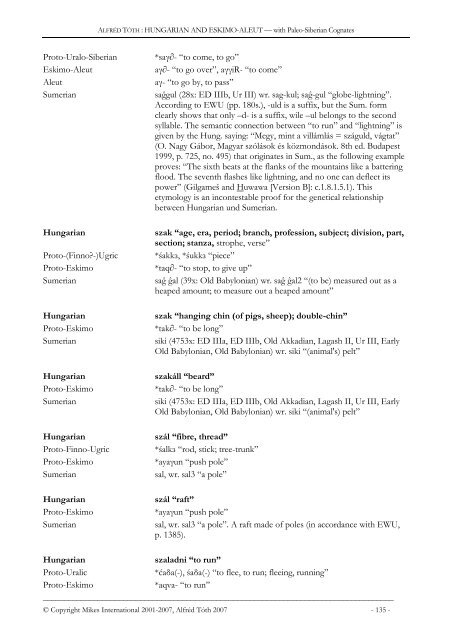Hungarian and Eskimo-Aleut
Hungarian and Eskimo-Aleut
Hungarian and Eskimo-Aleut
Create successful ePaper yourself
Turn your PDF publications into a flip-book with our unique Google optimized e-Paper software.
ALFRÉD TÓTH : HUNGARIAN AND ESKIMO-ALEUT — with Paleo-Siberian Cognates<br />
Proto-Uralo-Siberian *saγ∂- “to come, to go”<br />
<strong>Eskimo</strong>-<strong>Aleut</strong> aγ∂- “to go over”, aγγiR- “to come”<br />
<strong>Aleut</strong> aγ- “to go by, to pass”<br />
Sumerian saĝgul (28x: ED IIIb, Ur III) wr. sag-kul; saĝ-gul “globe-lightning”.<br />
According to EWU (pp. 180s.), -uld is a suffix, but the Sum. form<br />
clearly shows that only –d- is a suffix, wile –ul belongs to the second<br />
syllable. The semantic connection between “to run” <strong>and</strong> “lightning” is<br />
given by the Hung. saying: “Megy, mint a villámlás = száguld, vágtat”<br />
(O. Nagy Gábor, Magyar szólások és közmondások. 8th ed. Budapest<br />
1999, p. 725, no. 495) that originates in Sum., as the following example<br />
proves: “The sixth beats at the flanks of the mountains like a battering<br />
flood. The seventh flashes like lightning, <strong>and</strong> no one can deflect its<br />
power” (Gilgameš <strong>and</strong> Huwawa [Version B]: c.1.8.1.5.1). This<br />
etymology is an incontestable proof for the genetical relationship<br />
between <strong>Hungarian</strong> und Sumerian.<br />
<strong>Hungarian</strong> szak “age, era, period; branch, profession, subject; division, part,<br />
section; stanza, strophe, verse”<br />
Proto-(Finno?-)Ugric *śakkз, *śukkз “piece”<br />
Proto-<strong>Eskimo</strong> *taq∂- “to stop, to give up”<br />
Sumerian saĝ ĝal (39x: Old Babylonian) wr. saĝ ĝal2 “(to be) measured out as a<br />
heaped amount; to measure out a heaped amount”<br />
<strong>Hungarian</strong> szak “hanging chin (of pigs, sheep); double-chin”<br />
Proto-<strong>Eskimo</strong> *tak∂- “to be long”<br />
Sumerian siki (4753x: ED IIIa, ED IIIb, Old Akkadian, Lagash II, Ur III, Early<br />
Old Babylonian, Old Babylonian) wr. siki “(animal's) pelt”<br />
<strong>Hungarian</strong> szakáll “beard”<br />
Proto-<strong>Eskimo</strong> *tak∂- “to be long”<br />
Sumerian siki (4753x: ED IIIa, ED IIIb, Old Akkadian, Lagash II, Ur III, Early<br />
Old Babylonian, Old Babylonian) wr. siki “(animal's) pelt”<br />
<strong>Hungarian</strong> szál “fibre, thread”<br />
Proto-Finno-Ugric *śalkз “rod, stick; tree-trunk”<br />
Proto-<strong>Eskimo</strong> *ayaγun “push pole”<br />
Sumerian sal, wr. sal3 “a pole”<br />
<strong>Hungarian</strong> szál “raft”<br />
Proto-<strong>Eskimo</strong> *ayaγun “push pole”<br />
Sumerian sal, wr. sal3 “a pole”. A raft made of poles (in accordance with EWU,<br />
p. 1385).<br />
<strong>Hungarian</strong> szaladni “to run”<br />
Proto-Uralic *ćaδa(-), śaδa(-) “to flee, to run; fleeing, running”<br />
Proto-<strong>Eskimo</strong> *aqva- “to run”<br />
___________________________________________________________________________________<br />
© Copyright Mikes International 2001-2007, Alfréd Tóth 2007 - 135 -

















